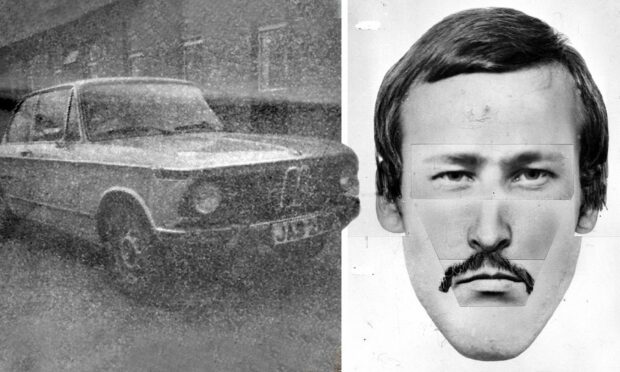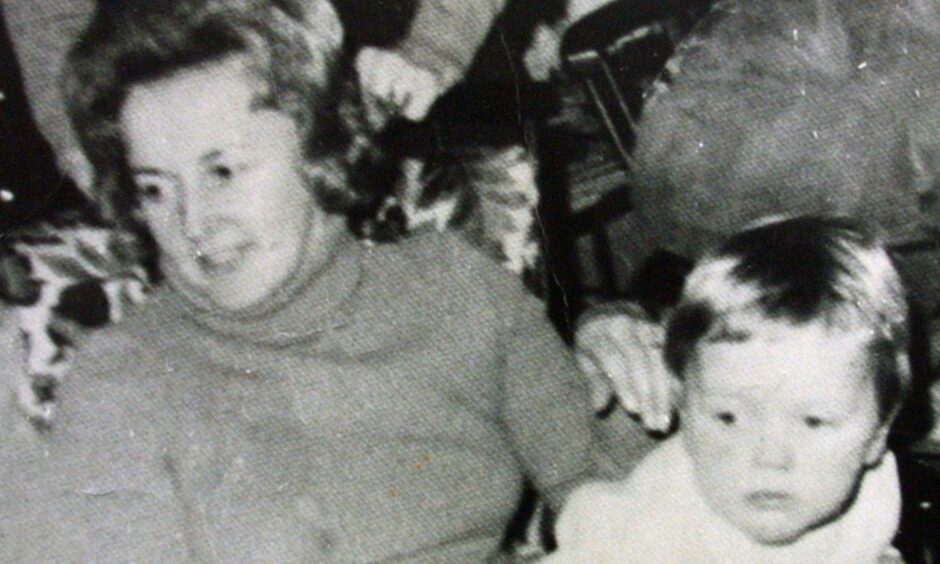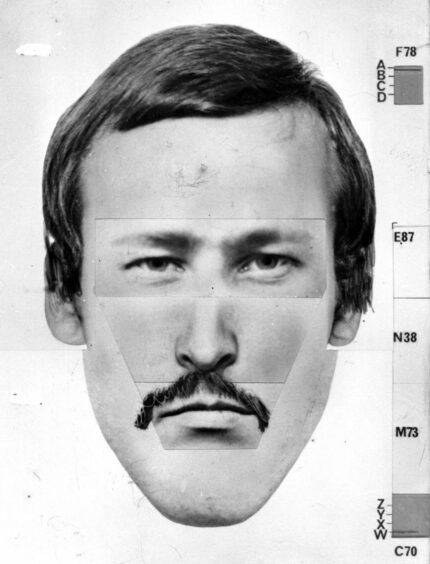Among the many threads that spun out of the Renee MacRae murder trial, her possible involvement with a man with a “Mexican moustache” was one of the most unusual.
In the weeks after the disappearance of Renee and her three-year-old son Andrew, police believed this man could hold the key to solving the mystery.
They even released a photofit of him at a press conference on November 24, 1976.
That prompted a “significant response” from the public.
It was so intense that a few days later, Northern Constabulary’s chief constable Donald Henderson said the bulk of the calls to a confidential line about the case were about “the Mexican”.
During the final week of November, this was the talk of Inverness and beyond.
The hunt for ‘Mr X’
It seemed promising.
On November 20, detective superintendent Ian Cameron said this man – who had also been dubbed Mr X in the press – had been spotted in Renee’s blue BMW saloon a few days before she vanished.
Police believed at the time that she may have talked to him about her plans.
Det Supt Cameron said: “We do not know who he is. But he may have some information that can help us.
“Mrs MacRae may have said something in conversation that may be relevant to inquiries.”
A few days later, the photofit was released and the phones started ringing.
By December 3, the goalposts had shifted slightly.
Police now described the mystery man as “heavier about the eyes and jaw”. He had a thicker, shorter moustache and slightly shorter hair.
That description fit a man who was found in Darlington town centre and later taken to hospital.
The man had been communicating with police using notes. He said he had been a mental patient in a hospital near Oban or Fort William.
Inspector George Black, a press liaison officer with Northern Constabulary, said: “There is no suggestion that this may be the chap we are looking for.
“But we are nevertheless checking him out.”
What happened next?
What happened next, effectively, was nothing.
At least publicly.
There was not much more disclosed about the “Mexican moustache”. But behind the scenes, police were working hard to figure out the significance of the sightings.
As we now know, that work continued through to the most recent re-investigation into the case.
Given what we saw during the recent three-week trial at the High Court, it makes sense that it never really went anywhere.
Bill MacDowell was convicted of the murders of his former lover Renee and their three-year-old son Andrew.
MacDowell, who turned 81 on Monday, was given a life sentence and will serve a minimum of 30 years before he is eligible for parole.
His defence team, led by Murray Macara KC, highlighted the potential significance of a moustachioed man being spotted with Renee before she vanished.
Two of the defence’s four witnesses were asked to recall a time they saw him.
Was he a Highland League goalkeeper?
Dr Alfred Gamblin, who was Renee’s GP, told the court that he had seen a man with a handlebar moustache in her car outside his practice shortly before she vanished.
It was like the one in the police photofit.
Dr Gamblin said the man’s girlfriend was a patient at the practice.
He told the police about the sighting via a confidential phoneline. At one point, Dr Gamblin identified him as a goalkeeper for a local Highland League club.
Another witness, Brian Rizza, 72, recalled seeing Renee’s car.
He said a “gentleman with a heavy, black Mexican moustache” was in it.
John Grant, the owner of Crown Grocery Stores at the time, said he remembered seeing Renee in her car, accompanied by a man in the passenger seat.
He was described as 45 to 55, with a broad build, dark hair and a “Mexican-style” moustache.
Mr Grant later said he couldn’t claim that it was “a positive sighting”.
Police rule out sightings
Placing Renee with this unknown man could have shifted the finger of blame away from MacDowell.
But the police had done their homework too.
Various witnesses said they saw combinations of Renee, her car and the moustachioed man on occasions in late October and early November 1976.
Detective Chief Inspector Brian Geddes, who led the most recent investigation into the case, told the court that police had ruled out each sighting.
There was a sighting on October 21 on the Beauly road. But Renee’s car had been in the garage at that time.
One witness said he was confident he knew Renee’s car because he had seen her driving it for the past three years.
However, investigations showed she had only been driving it since earlier in 1976.
There were another two possible sightings in Telford Street.
The first was on November 5.
But the brother of the witness said it couldn’t have been on that date and might have been on November 12.
Renee’s housekeeper Margaret Ross said she was at home in Cradlehall Park on the later date.
During another sighting, on November 11, Mrs Ross also placed Renee at home.
Why was it described as ‘Mexican’?
It seems unlikely we’d ever hear the police describing someone’s facial hair as “Mexican” in the modern day.
At the time, they simply meant it was drooped over the sides of the man’s mouth.
The revised description that it was shorter made it a potential minefield for police.
After all, there were probably a lot more men with moustaches in 1970s Inverness than there are today.
Among the many twists and turns of the case, this one was most of the most bizarre.
More on the Renee MacRae case:
- Guilty: Pensioner murdered secret lover Renee MacRae and their toddler son Andrew, jury decides
- Agitated, dizzy and ‘probably’ telling the truth: The point the Renee and Andrew MacRae murder trial turned
- Long read: Four decades on, the many twists and turns of the Renee and Andrew MacRae case
- The moment of justice: Cries of relief from Renee MacRae’s family while her killer sits emotionless in the dock
- Renee and Andrew MacRae trial: The 15 images that led to Bill MacDowell’s conviction





Conversation